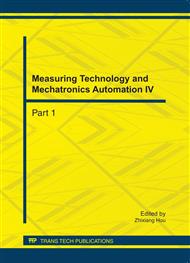p.807
p.811
p.815
p.819
p.825
p.829
p.834
p.842
p.846
Distributed High-Precision Field Testing System of Construction Machinery Based on CAN Bus
Abstract:
The main objective of this work is development of a type of status parameter testing system based on CAN bus for construction machinery. Various difficulties due to over-abundant parameters of testing and controlling, many different types of transducer, changes and anomalies in the operation temperature and harsh EMI environment are considered in the accomplishment. The design of intelligent field testing node is demonstrated in detail. The intelligent node consists of embedded microcontroller AT89C52, high-precision signal conditioning circuits, CAN interface module and other peripheral circuits. The intelligent node uses software auto-zero correction and full-scale correction as well as the method of second-degree parabola interpolation to deal with the non-linear characteristic of the measured data. Hence, it implements the high-precision detection and measurement. In addition, the intelligent connects to the host computer via CAN bus to form a distributed high-precision status parameters testing system. The hardware circuit of operation status parameters measurement and communication interface circuit are developed and described, and the software is also accomplished with C language and LabVIEW. The system has the advantages of simple structure, reliable performance, significant capability of real time processing, powerful anti-jamming performance and so forth. Meanwhile, the system has great application prospect.
Info:
Periodical:
Pages:
825-828
Citation:
Online since:
October 2011
Authors:
Price:
Сopyright:
© 2012 Trans Tech Publications Ltd. All Rights Reserved
Share:
Citation:


